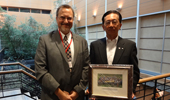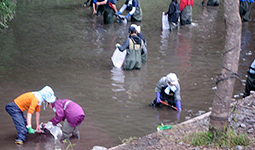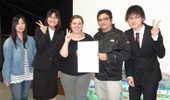Dr. Christopher Thompson, Chair of Linguistics in the Ohio University College of Arts & Sciences and Executive Director of Japan Relations, represented Ohio University at a farewell reception for Consul General Kuninori Matsuda at the Japanese Consulate in Detroit on June 21.
“Ohio University wishes to express its sincere gratitude for the many contributions that Consul General Kuninori Matsuda has made at the Consulate General of Japan in Detroit,” said Ohio University President Roderick J. McDavis. “His insights have led to a deeper international understanding and cultural appreciation of Japan and its ties to Ohio, which fuels our ongoing tsunami relief efforts. In addition, his professional guidance has enabled Ohio University to begin many important relationships with well-respected Japanese agencies, resulting in unprecedented opportunities.”
“Consul General Matsuda’s interest in Ohio University has opened doors in Japan and connected us with Japanese people and organizations that would not have otherwise been possible. His support of our interest in Japan at the personal, professional, and academic levels has been truly outstanding,” said Dr. Christopher Thompson, Chair of the Linguistics Department in the Ohio University College of Arts & Sciences and Executive Director of Japan Relations.
“Ohio University, established in Athens, Ohio in 1804, enjoys a long history with Japan. A little known fact about the university, commonly referred to as OHIO, is that our first international student was from Japan. Sakitaro Murayama, a graduate of a university in Tokyo in 1890, earned a BS degree in Electrical Engineering at OHIO in 1895. Amazingly, he accomplished this feat in just one academic year!” wrote Thompson in a guest column in the December 2012 newsletter of the Japan External Trade Organization.
“Almost 118 years later, the campus continues to boast a variety of extraordinary Japan ties: OHIO’s 15th President Dr. Vernon Alden (1962-1969) received the Order of the Rising Sun from the Japanese government; the 200 cherry trees that line the Hocking River on the southern edge of campus were a gift from Chubu University in Aichi, a strategic partner since 1973; and the university’s Japanese Language Program is the second largest in the state (in 2011) with 220 students. OHIO also has a direct link to Iwate Prefecture and Japan’s March 2011 triple disaster as it unfolded there, via ties cultivated during my 25 years of ethno-graphic research in the region.
“In September 2011, Associate Dean of the College of Arts & Sciences Tom Scanlan and I dispatched a team of students, faculty, and alumni to the Rikuchu Coast in northeast Honshu to help with the tsunami recovery efforts. This initiative, sanctioned by current President Dr. Roderick J. McDavis, is part of a five-year outreach partnership with the students and faculty of Iwate Prefectural University (IPU) to support 3.11 victims in remote areas of Iwate’s northern coast. During year-1, the OHIO-IPU volunteer team helped to remove tsunami rubble from a salmon stream in Otsuchi, and visited a kindergarten nearby to read kamishibai to 20 preschool tsunami survivors.
“Hearing of OHIO’s strong Japan ties and unique 5-year commitment to Iwate, the Consul General of Japan in Detroit, Kuninori Matsuda, visited Athens in May 2012 to thank us for our efforts and to learn more about our institution. He also shared with President McDavis, OHIO faculty and students his vision for how economic lessons learned from 3.11 could/should be applied in Ohio to create new opportunities for companies in both America and Japan. The 3/11 tsunami demonstrated to all Japanese and Japan-related companies all over the world the importance of diversifying production capabilities outside of Japan, he suggested. In Ohio, however, the traditionally industrial areas located in the three C’s (Cleveland, Columbus, and Cincinnati) are already saturated with Japan-related commercial activity, so there is no more room for growth, he explained. Considering OHIO’s historical connection to Japan, its excellent Product Innovation Center and business incubator program, the untapped human and natural resources close by, and proximity to the Ohio River (expected to become a major artery of inexpensive water transportation between Asia and the Midwest in the coming years), Southeast Ohio is definitely the most logical place for a Japan-related company to want to expand or start something new, he preached. The quality of life available in Athens and OHIO’s outstanding ESL programs both at the university and in the local public schools would certainly be attractive to Japanese companies and their Japanese employee’s families as well, he added. Subsequent conversations with representatives from JETRO Chicago reinforced Consul General Matsuda’s observations,” noted Thompson in his column. The 2013 volunteer team will again travel to Iwate in September.
“In September 2012, I led OHIO’s second tsunami recovery volunteer trip to Iwate. Tom and I were accompanied by Provost Pam Benoit and VP for Research Joe Shields. Encouraged to promote OHIO in Japan by Consul General Matsuda and our friends at JETRO Chicago, we arranged meetings with Mitsui-Sumitomo Bank, Fuji Electric, Nichirei Biosciences, and Idemitsu Kosan, all organizations with an interest in the Midwest. Initially the companies were somewhat surprised by our request for a meeting, but as we began our presentation on OHIO’s Japan connection, the emerging economic opportunities in southeast Ohio, and our institutional assets, the people we met quickly understood the purpose of our visit. Reciprocally, we let them know that we also understood that cultivating deeper business relationships would take much more than a single visit.
A key part of the relationship between Ohio University and Japan is the establishment of a service-learning project in response to the Great East Japan Earthquake and tsunami in 2011. A three-year grant from the TOMODACHI Initiative will help fund OU students and alumni as they travel in Sept. 26-29 and will form the foundation for long-term service-learning opportunities in Japan.
The TOMODACHI Initiative is a public-private partnership, born out of support for Japan’s recovery from the Great East Japan Earthquake, that invests in the next generation of Japanese and American leaders through educational and cultural exchanges as well as entrepreneurship and leadership programs. The U.S.-Japan Council (Japan) is a Public Interest Corporation (Koeki Zaidan Hojin), which manages and supports programs and activities that enhance personal connections, promote people-to-people ties between Japanese and Americans of all generations, and strengthen educational, cultural, and economic ties and deepen the long-term friendship between Japan and the United States. The core business of the U.S.-Japan Council (Japan) is to establish the foundation of the TOMODACHI Initiative.
In April of this year, reporters Yoichi Takeuchi and Conrad Chaffee from Tokyo-Chunichi Shimbun photographed the blossoming of the cherry trees at Ohio University with students are from the Ohio University Linguistics program and from Chubu University (studying in the Ohio Program of Intensive English). View the photos. View the Sakura Watch website.
Read more about Ohio University’s relationship with Japan and the Consulate General of Japan in Detroit:
- Ceremony to honor victims of Japan’s earthquake, tsunami (Compass 2011) and YouTube video
- University honors victims of recent earthquake, tsunami (Compass 2011)
- Kuninori Matsuda, the Consul General of Japan in Detroit, to discuss the importance of building economic relationships and language learning (Post 2012)
- Ohio University Tsunami Relief Trip to Iwate (Year One), by Brandon Dohner (2011)
- Ohio University students to assist with tsunami relief in Japan (Compass 2011)
- OHIO students reflect on service to tsunami-ravaged region of Japan (Compass 2011)
- Ohio University Reaches Out To Tsunami Victims In Japan (WOUB 2011)
- Ohio University Tsunami Relief Trip to Iwate (Year Two), by Josh Garret, and photos




















One Comment